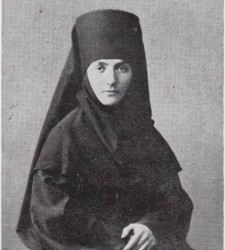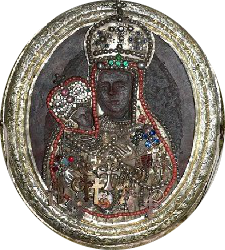From October 16th – 22nd 2025, it was an honor to host Mother Evfrosinia of Lesna Convent on a pilgrimage to Ephesus, a much-deserved rest for her after the strenuous organization of the patronal feastday of her convent, Lesna, which also celebrated the 140th anniversary of its founding.
Matushka Evfrosinia came equipped with her own knowledge and veneration of St. John, which enriched our time spent with her.
Upon arriving at the Hermitage, Matushka was immediately struck by its proximity St. John’s very tomb; how we came to have such a place, she agreed, upon hearing the whole story, is clearly a miracle.
Day 1: The Sepulcher Basilica of St. John and Ayasoluk (Agios Theologos) Hill
On the first full day of Matushka’s time in Ephesus, our first destination, of course, was the basilica complex of St. John. Bishop Akakije hosted the tour in Russian, aided by pictures brought to illustrate various details and reproductions of the basilica and the surrounding area, which he had acquired during his research.
After entering through the monumental gates, the tour begins with an examination of a model of the surrounding region to orient the pilgrim
.png)
After examining the 3D model of the region, one can turn west to see the valley of Ephesus, which, thank God, still preserves an air of antiquity. In the distance, from left to right, can be seen the hills where the Seven Youths slept, the hill where St. Paul was imprisoned, the hills between which lie the ruins of Ephesus, and the shimmering Aegean. The largest building to the right is Isa Bey mosque (14th c.), notable for being one of the oldest and most impressive works of architecture from the Anatolian Beyliks; of course, its architecture imitates that of the Byzantines, so in that sense it is not wholly incongruous to the Christian eye searching for hints of the rich Christian culture that once thrived here.
Downhill, between the basilica complex and Isa Bey mosque can be seen the ruins of an Orthodox monastery
View to the east: the atrium, then the entrance into the basilica in the distance
.png)
Then one enters from the narthex to get a perspective of the church nave, while being shown some reproductions of the church
One cannot help but be awed by the dimensions of the church, even in its only partially reconstructed state
Noting the cross-shape of the church and the location of the accompanying side rooms, baptistry, etc.
The altar and opening to St. John’s tomb from which the miraculous dust used to spout. After an overall tour, with just the singing of the Troparion to St. John, Matushka would have the opportunity to come back on a different day to just pray at the tomb and soak everything in once more.
More examination of models
After getting a good acquaintance with the Basilica, the next step is to go up to the top of the hill to the place where St. John wrote his gospel
Leading to the top of Ayasoluk hill, crowned by an Ottoman fortress, built on the foundations of the Byzantine
As one goes up, the views become more stunning.
On top of the hill: Where St. John wrote the gospel. The church built over that holy place was mostly demolished by the Ottomans, who left only the altar, which they walled up to serve as a cistern.
.png)
At least this holy place is still marked and preserved, even if it has been stripped of its former ecclesiastical beauty.
Day 2: Holy Liturgy in honor of Ephesus Saints Adauctus and Callisthene, Ephesus Museum
September and October are especially filled with Ephesus saints, and we were blessed, on Friday, Oct. 4/17, to celebrate Holy Liturgy in memory of Ephesus Saints Adauctus and Callisthene (4 c.). Even with the time constraints, Bishop Akakije quickly sketched an icon and composed a troparion and kontakion in their honor, which can be seen with the link above embedded with their names.
Afterwards, we visited the Ephesus Museum, which is fairly small considering the importance of this ancient city, but still gives one an idea of its former glory. Matushka, who in the world was educated in art history, remarked on the quality of the pagan statues, which indicate the great prosperity of the region and remind us of what a great pagan stronghold this was when the Apostles came to preach.
The most significant items from an Orthodox point of view are genuine clay ampoules which were used for carrying the miraculous dust of St. John’s tomb.
There are also a few beautiful crosses and reliquaries.
Matushka enjoyed the excellent coin collection, where we found which coins would have been used by the Seven Youths of Ephesus which shocked the Ephesians after their 200 year dissapearance, and the corresponding coins which they should have been using at the time.
It is fascinating to see the remains of huge statues of pagan emperors (who were worshipped as gods), which the Christians later eched with crosses, perhaps a way of exorcising their pagan past and baptising their city.
Though regrettably, most of the statuary that the locals choose to exhibit is pagan, some traces of Christianity still slip through, like this marble slab representing the sacrifice of Isaac.
The more time we spend in Ephesus, the more traces of Christianity we discover.
Day 3: Rest, Market, and Meryamana
On Saturday, Matushka rested for a bit, then we took her for a walk to a bit of Selçuk and enjoy the very oriental (and ancient) experience of the Saturday outdoor market.
In the afternoon, we went to Meryamana, called by the Roman Catholics the House of the Virgin; for the Orthodox, however, there is no record of it being such a thing, but it is an ancient church, built on the foundations of an even more ancient church dedicated to the Theotokos. There is also a miraculous spring of water (agiasma) where we always fill up plenty of water.
This ancient holy site is in a lush forest on top of Mt. Bulbul, which one can imagine must have been a beautiful place for a monastery.
Day 4: Holy Liturgy and Ancient Ephesus
On Sunday, after an early Holy Liturgy, we completed our official tour with a visit to the ruins of Ephesus. Sadly, almost all traces of Christianity have been hidden or erased from this massive archaeological site, one of the largest of its kind in the world. If you follow the official tour and audio guide, the great Christian monument of the Church of Our Lady, or the church of the Third Ecumenical Council, is the last thing that you see, and even easy to miss or skip. We, however, having found after several visits a shortcut to the church, an almost invisible path right from the lower entrance to the site, began with this great church. Beginning the tour with the monumental church puts you into a completely different frame of mind, and with that, the city itself, despite all the efforts of its non-Christian proprietors, comes into a completely different light.
As we approached the church, we were struck by the sight of some new ruins that must have been uncovered recently. These were of a massive gymnasium. During pagan times, the gymnasium served for the training of athletes, but we postulate that during Christian times, it might well have become a theological school, as it is located right next to the great church. Rising above both, farther west (not shown here) is a hill which is remembered as the place where St. Paul was imprisoned. At the time, this hill was probably a sort of island, but the water has retreated over the centuries due to silting of the Meander river. We imagined how St. Paul, from his viewpoint over the city, and immediately looking at the gymnasium where the athletes trained, was inspired to write, Put on the whole armor of God, that ye may be able to stand against the wiles of the devil… (Eph. 6:11).
The ruins of the church
Approaching the church from the back; opposite the church was the bishop’s palace, who would have had a direct entrance into the altar from his residence…
The pulpit from which St. Cyril of Alexandria anathematized Nestorius. Matushka holds a reproduction of the Ephesus Icon of the Theotokos which, according to tradition, was painted by St. Luke, and was kept in this church. Later, it was gifted to Matushka’s own name saint, St. Euphrosynia of Polotsk, by the Byzantine Emperor Emmanuel Komninos. Now it is known as the Toropets icon of the Theotokos, as it was kept in that city. Today it can be found in the Alexander Nevsky Church in Kniazhevo Ozero, some distance away from Moscow.
Studying the „double“ structure of the church, the first church was larger, but when it fell into disrepair, a smaller church was built within it.
View from the atrium towards the narthex.
One can only imagine the splendor of this church in its day.
View of the gymnasium from the church.
After venerating at the church, we walked towards the ruins of Ephesus. Below is shown the harbor road, which leads from the port to the center of town.
Presenting the city as a tourist attraction, emphasis is put on the fact that this road was used for the processions of the emperors; but to us, we can reflect on how it is the same road the Apostles used to come preach the word of God to the Ephesians.
The harbor road leads to the center of cultural life in Ephesus: the great amphitheater, which could seat 25,000 people. This was where the great riot in praise of Diana occurred, as recounted in Acts 19. It is amazing to reflect on the grace given to the Apostles, which gave them the strength to overcome such earthly powers.
The agora where the Apostles preached
The library of Celsus (1st century AD), which was the third largest library in the ancient world after Alexandria and Pergamum

Walking up Curetes Street, one of the three main streets, towards the other entrance to the city
Well-preserved Roman statues reveal the origins of the clothing depicted in icons.
More echoes of magnificence: the temple of Hadrian (1 c. AD), which we can also postulate was turned into a Christian church.
Even this rather cursory exploration of the ancient city left us with a strong impression of its magnificence both as a battlefield for the spreading of the gospel and later a shining beacon in Christendom.
Our last stop would have been the cave of the Seven Youths of Ephesus, but unfortunately, it is inaccessible due to archeological research, projected for the next two years.
Instead, Matushka enjoyed some quiet time at our Hermitage, where we maintained our regular cycle of prayers, Canon, and Akathist to St. John the Theologian. She had the time to make her own quiet trip to pray at St. John’s tomb without haste.
We also made a little trip to the Aegean, where St. John floated, shipwrecked, for fourteen days before being washed up on these shores.
.png)
Through the prayers of St. John the Theologian and all of the saints of Ephesus, may we safely navigate the seas of life and be brought to the eternal harbor of salvation!
Источник: https://stjohnshermitage.blogspot.com/2025/10/the-pilgrimage-of-abbess-evfrosinia-of.html#more



.png)
.png)

.png)
.png)
.png)
.png)
.png)
.png)

.png)
.png)

.png)
.png)
.png)
.png)
.png)
.png)
.png)



















